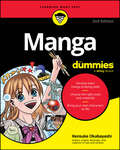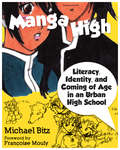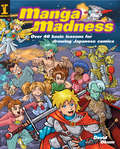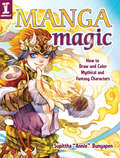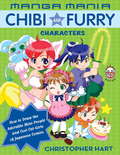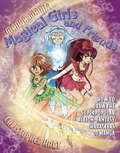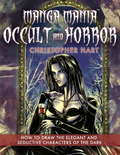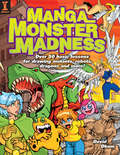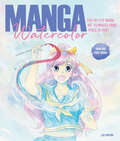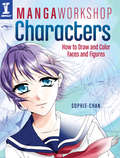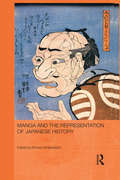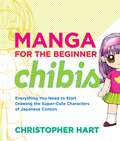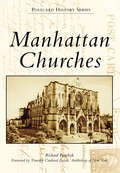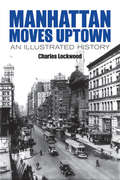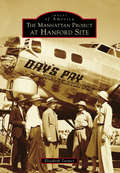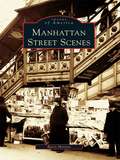- Table View
- List View
Manga For Dummies
by Kensuke OkabayashiGet started with the powerful visual language and storytelling medium that is manga Manga is a unique style of drawing. It's also a great way to make topics like history and politics appealing to a wide audience. Manga For Dummies teaches you the basics of drawing in the manga style. This step-by-step guide shows you how to apply the basic rules of manga figure drawing, whether you're a complete beginner or a professional artist. You'll learn how to create manga characters, from rough sketch through final rendering. Simple drawing exercises help you build and develop your skills. Plus, you can add interest and depth to your drawings with ideas and techniques from a manga pro. This book also covers how to create scripts and storyboards, so you can tell a great manga story from start to finish. Gather the tools you'll need—including the latest digital illustration tools Learn what makes manga drawing different from other illustration styles Create compelling characters, storylines, and visual settings Share your creations and be a part of the manga community on social media If you're a fan of manga and other graphic arts and would like to start drawing your own characters and stories, this is the Dummies guide for you. Designers, artists, and writers of all skill levels are welcome!
Manga High: Literacy, Identity, and Coming of Age in an Urban High School
by Michael Bitz Françoise MoulyBased on a four-year study, Manga High explores the convergence of literacy, creativity, social development, and personal identity in one of New York City's largest high schools. Since 2004, students at Martin Luther King, Jr., High School in Manhattan have been creating manga--Japanese comic books. They write the stories, design the characters, and publish their works in print and on the Internet. These students--African-American and Latino teenagers--are more than interested in the art and medium of manga. They have become completely engrossed in Japanese language, culture, and society.Manga High is highlighted by reproductions and content analysis of students' original art and writing. An appendix includes guidelines for educators on starting a comic book club.
Manga High: Literacy, Identity, and Coming of Age in an Urban High School
by Michael BitzBased on a four-year study, Manga High explores the convergence of literacy, creativity, social development, and personal identity in one of New York City&’s largest high schools. Since 2004, students at Martin Luther King, Jr., High School in Manhattan have been creating manga—Japanese comic books. They write the stories, design the characters, and publish their works in print and on the Internet. These students—African-American and Latino teenagers—are more than interested in the art and medium of manga. They have become completely engrossed in Japanese language, culture, and society.Manga High is highlighted by reproductions and content analysis of students&’ original art and writing. An appendix includes guidelines for educators on starting a comic book club.
Manga Madness: Over 50 Basic Lessons For Drawing Warriors, Wizards, Monsters And More
by David OkumDraw awesome manga characters and scenes just like the pros! Capture the excitement of manga in your drawings! Inside you'll find hundreds of dynamic illustrations for achieving the hot, action-packed look you want. Loaded with detail and over 40 step-by-step lessons, you'll learn the skills and tips you need to create amazing characters and scenes. From drawing characters in cool poses to exploring visual storytelling,Manga Madnesswill show you the way! Drawing basics such as shading, perspective and foreshortening Japanese terms, traditions and character types Quick tips for having fun and improving your work From pretty girls and rebellious heroes to space pirates and giant robots, you'll get fast results for your best manga drawings yet!
Manga Magic: How to Draw and Color Mythical and Fantasy Characters
by Supittha Annie" BunyapenWhat do you get when you cross popular manga style with legends of old? Manga Magic! In this one-of-a-kind guide, beloved and prolific manga artist Supittha "Annie" Bunyapen (a.k.a. Ecthelian on deviantART) shows you how to put original spins on popular fantasy figures and creatures, with insight on everything from what they wear to where they dwell. Inside, you'll learn how to:Develop fantastic characters--from basic anatomy to important details like hair and skin tones.Design costumes fit for a goddess (or fairy, or Pan, or what-have-you) right down to armor, jewelry and footwear.Color with confidence. Achieve various results using basic watercolor techniques, special effects and markers.Set the scene with great backgrounds--from aerial views to underwater scenes.Bring it all together, step by step. 20+ start-to-finish demos feature a variety of mythic characters, from wood nymphs and Golem, to multiple gods and goddesses. Whether you base your characters on traditional Greek mythology, Japanese folklore or fantastical renditions of your own imagining, this guide will lead you step by step through the creation of your own magical manga worlds!
Manga Mania Bishoujo
by Christopher HartThis books shows aspiring artists exactly how to handle anatomy and muscles, hands and nails, seductive outfits, extreme hairstyles, body language and facial expressions -- everything you need to draw these powerful women of fantasy.
Manga Mania Chibi and Furry Characters
by Christopher HartEveryone loves chibi, the newest, hottest manga style out of Asia. Chibis--characters that range from hypercute miniature people to bizarrely sexy furry characters--come in all varieties, all roles, including chibi teenagers, faeries, schoolgirls, nurses, mermaids, devils, angels, and everything in between. Now Christopher Hart, the world's best-selling author of cartoon and drawing titles, shows readers exactly how to draw chibis, infusing them with personality and creating authentic costumes for them. Cute chibi-style monsters (small yet powerful), appealing cat-girls (humanlike, but with feline traits), superdeformed manga/chibi characters (used to make funny wisecracks)--every type of chibi character is shown here in crystal clear, step-by-step drawings. Manga Mania Chibi and Furry Characters will get every manga fan in on the chibi fun.
Manga Mania Magical Girls and Friends
by Christopher HartSailor Moon. Card Captor Sakura. Magical Girl Rayearth. They're magical girls, and they're some of the biggest names in manga. Magical girls, ordinary schoolgirls given superpowers, are hugely popular in Japan and the United States. Now Christopher Hart shows fans everywhere how to draw these manga shoujo faves. Faces and body proportions, action poses, costumes, expressions, transformations, special effects--they're all here, all in Hart's distinctive step-by-step approach. So are magical fighting boys and everybody's favorite, the cute, furry manga mascots. Hart demonstrates how to create funny mascots, magical boys, fighting teams, and supporting characters, plus how to design layouts. Magical girls show us that we all have special powers deep inside--now Manga Mania: Magical Girls and Friends let those special drawing powers reveal themselves at last!
Manga Mania Occult & Horror
by Christopher HartFrom seductive vampires to corrupt samurai to wicked werewolves, all the inhabitants of the manga occult-and-horror genre welcome you into their nefarious universe. The latest book in the Manga Mania series from best-selling author Christopher Hart takes readers through the world of manga horror and occult with sinfully easy step-by-step instructions and decadently lush color illustrations. Beautiful depravity becons. Evil never looked so good.
Manga Monster Madness: Over 50 Basic Lessons For Drawing Warriors, Wizards, Monsters And More
by David OkumTweens and teens will love drawing the monsters lurking in Manga Monster Madness. There's no need to fear putting pencil on paper with 50 easy-to-follow lessons for drawing everything from aliens and mutants to the supernatural.
Manga Studio Ex 5 Cookbook
by Elizabeth StaleyOver 90 hands-on recipes to help you create digital comics from page setup to exporting the final product About This Book * Design creative and custom digital comics with the perfection equivalent of pen-and-paper drawings * Explore the latest features from Manga Studio EX 5 such as custom brush effects, layers, masks, 3D objects, panels, and multiple-page story layout * A pragmatic manual with engaging recipes and attractive screenshots that make comic creation fun and easy Who This Book Is For This book is intended for competent comic artists working on Manga Studio who want to create more attractive comics by using powerful tools and features from software for digital comic creation. What You Will Learn * Create story files and custom pages for any Web or publishing project * Customize brushes for special ink effects, hatching and cross-hatching, and much more * Work with vector images in Manga Studio EX 5 * Use the new Symmetry ruler and the new Line tools to create your illustrations faster and more efficiently * Make and save custom screentones, and add them to your comic pages * Punch up your illustrations with color palettes and special effects * Add 3D models to create or accentuate your comic scenes * Finish a project by exporting it for the Web or for a printed collection In Detail Manga Studio is a software application for the digital creation of comics and manga. Manga Studio EX 5 has all the features of Manga Studio 5, professional story creation tools, and other special features that make it the ultimate illustration tool for serious comic, manga, and graphic artists. Made specifically for comic artists and illustrators, it has some of the most powerful digital art creation tools available. From digital perspective rulers to a library of screentones, Manga Studio 5 works for the artist with an intuitive, customizable interface and tools. With Manga Studio EX 5, you can create custom page templates, save commonly used designs, make custom brushes, mimic traditional media, pose 3D objects directly on the art canvas, and export all of your comic pages for print or the Web. The book starts with everything you need to know to set up custom pages for your comic or Manga project. These recipes will take you all the way through to exporting your illustrations for print or to display them on the Web. You will learn how to create custom brushes that you will use for inking, or for repetitive tasks such as drawing foliage or rubble. Next, you will move on to understanding Layer Modes and Layer Masks. Then, you'll learn how to finish up your illustrations with color, screentones, special effects, and 3D objects. Finally, you will be taught to export your hard work and share it with the world, either through the Web or in print. This cookbook will give you just the right recipes to turn on the power of Manga Studio EX 5 and get you creating more illustrations faster and more efficiently. Style and approach An easy-to-follow, and informative book full of recipes that explore real-world topics for the comic creator. Each recipe is explained with detailed steps and interesting screenshots.
Manga Watercolor: Step-by-Step Manga Art Techniques from Pencil to Paint
by Lisa SantrauLearn how to create beautiful manga art from pencil sketch to finished painting, with this comprehensive guide. As the popularity of Manga art continues to soar, manga and comic book artist Lisa Santrau shows beginners how to create subtle and beautiful manga pictures using pencil and watercolors—the simplest of art materials. Lisa explains the materials and tools needed and then explores the fundamentals of how to draw manga—from color theory and breaking down drawings into basic shapes, to body proportions and faces for both classic manga and chibi manga figures. You will learn how to sketch, how to create depth in your work with shading, and a range of watercolor techniques including washes, wet-on-wet and layering, as well as special techniques involving masking fluid and an innovative &“film&” technique for creating texture and patterns. The exercises that follow the basics explore a wide range of techniques including manga poses, hair and eyes, then learn about backgrounds, textures, gradients and more. Finally, there are twelve step-by-step painting projects to perfect your manga art skills, with downloadable templates if you want to skip the drawing and get straight to the painting. The projects are varied and fun, and comprise: Sweet chibi girl on a slice of cake, using the dry technique Fresh steampunk chibis against a bright background, using the wet-on-wet technique Chibi sorcerer&’s apprentice in a flying teacup, with a galaxy background Chibi Harry, aka a world-famous wizard, teaching you character design Young girl framed by a romantic floral design, using a monochrome palette Sailor boy in a symbolic sun circle, created with masking fluid Girl in a kimono backlit by a window with flowers, using the white of the paper Historical heroine in a voluminous ballgown, using the film technique Melancholic schoolgirl against a fluorescent background, again with the film technique Silhouette in the evening sunset, using the wet-on-wet technique Food overload boy in the land of plenty, featuring surface textures Girl&’s face with expressive eyes, exploring cool versus warm colors This easy-to-follow book by the creator of the popular Mechanical Princess comics, contains all you need to successfully paint your own watercolor manga art.
Manga Workshop Characters: How to Draw and Color Faces and Figures
by Sophie ChanCreate your own manga characters!The manga universe is diverse--full of cute chibis, soulful romantics, cunning villains and sassy schoolgirls. Whether you want to tell love stories, create fantasy worlds or explore the drama of everyday life, you can do it with the help of self-taught manga artist and YouTube celebrity Sophie-Chan. You'll learn to draw personality-filled characters and create unique manga stories from start to finish, even if you've never drawn manga before!Inside Manga Workshop:30+ start-to-finish demonstrations teach you to draw women, men and children of all ages, perspectives and personality types, including classic manga schoolgirls, the boy next door, businesswomen, rock stars and gothic vampires.The Face. Using simple shapes, draw different eyes, noses and mouths to create endless expressions, from blushing surprise and happiness to full-blown tears--even cool hairstyles!The Figure. Follow easy guidelines to create proportionate characters--chibis and children, high schoolers and warriors--and place them in scenes. Plus, learn the secrets to drawing accurate hands and feet, including shoes!Color. Learn to color your manga with colored pencil, markers and digital drawing programs to reflect setting, genre, time of day and personality traits.Bonus pages show variations on facial expressions, common poses, extra outfits and how to use each in your story, plus special drawing demos, including an angel, vampire, witch, a magical cat and Chan's own characters.Includes publishing tips, words of advice and insider secrets!
Manga and the Representation of Japanese History (Routledge Contemporary Japan Series)
by Roman RosenbaumThis edited collection explores how graphic art and in particular Japanese manga represent Japanese history. The articles explore the representation of history in manga from disciplines that include such diverse fields as literary studies, politics, history, cultural studies, linguistics, narratology, and semiotics. Despite this diversity of approaches all academics from these respective fields of study agree that manga pose a peculiarly contemporary appeal that transcends the limitation imposed by traditional approaches to the study and teaching of history. The representation of history via manga in Japan has a long and controversial historiographical dimension. Thereby manga and by extension graphic art in Japanese culture has become one of the world’s most powerful modes of expressing contemporary historical verisimilitude. The contributors to this volume elaborate how manga and by extension graphic art rewrites, reinvents and re-imagines the historicity and dialectic of bygone epochs in postwar and contemporary Japan. Manga and the Representation of Japanese History will be of interest to students and scholars of Asian studies, Asian history, Japanese culture and society, as well as art and visual culture
Manga for the Beginner Chibis (Christopher Hart's Manga for the Beginner)
by Christopher HartThe ultimate guide to creating chibis!They populate manga with chunky bodies, oversized heads, and huge expressive eyes. They're schoolgirls and schoolboys, magical girls and mad scientists, fairies and fighter princesses, cyborgs and sci-fi secret agents, bikers and bad samurais, robots and rebel leaders. They've even got chubby pets and zany monster sidekicks! They're chibis!Excruciatingly cute, highly stylized, and beloved in all manga genres (fantasy, magical girls, shounen, anthro, sci-fi-, and more), without them, manga would barely exist. And now you can learn, step by step, how to draw virtually every chibi out there, how to "chibify" ordinary manga characters--and how to invent your very own designs! Covering facial expressions, those iconic manga eyes, costumes, character interaction, and story settings, Manga for the Beginner Chibis has it all.From the Trade Paperback edition.
Manga for the Beginner Kawaii: How to Draw the Supercute Characters of Japanese Comics (Christopher Hart's Manga for the Beginner)
by Christopher HartKawaii—so cute it hurts! You probably know this already, but the superpopular manga genre of Kawaii is everywhere! From Hello Kitty to Pokémon, these supercute Kawaii creatures are taking over. These characters are intensely cute, simple to draw, and colorfully graphic. The Kawaii genre puts its supercute stamp on a variety of well-known manga staples from adorable anthros to lovable monsters and animals to dark-but-still-cute Goths. Even the breathtaking and beautiful ladies of the Kawaii subgenre moe get their turn in the spotlight. The undisputed master of manga, Christopher Hart provides you with all the tools and techniques you will need to bring these beloved Kawaii characters to life. The supercute drawings and step-by-step directions provide you with everything you need to draw with Kawaii-style charm and personality. From color contrasts to simplifying designs,Manga for the Beginner Kawaiiprovides the complete inside scoop on what it takes to make it as a Kawaii artist. This is the ultimate guide to bringing supercute characters from manga’s most adorable genre to life.
Manga for the Beginner Midnight Monsters: How to Draw Zombies, Vampires, and Other Delightfully Devious Characters of Japanese Comics (Christopher Hart's Manga for the Beginner)
by Christopher HartUsing step-by-step instruction on how to draw Japanese manga and anime zombies, vampires, and monsters, best-selling author Christopher Hart teaches artists how they can create their own spooky manga characters. With the occult running rampant in today's television, movies, and other media, it's no wonder that the scary, monstrous, and dark characters of manga have become so popular. From drawing monster eyes to goth boys, Manga for the Beginner Midnight Monsters teaches artists how to draw these creepy and mysterious characters that they just can't get enough of. Packed with expert tips on drawing: · Zombies · Vampires · Werewolves · Goths · Witches · Sorcerers · And so much more!
Manga for the Beginner Shoujo (Christopher Hart's Manga for the Beginner)
by Christopher HartThe ultimate guide to creating the most popular form of manga--shoujo!If you're reading this, you already love shoujo. But now you'll be able to take the next step and actually write and draw your very own. The teen characters that populate the genre are outrageously cool, including magical girls, demon gals, cat girls, J-rockers, handsome teen boys, Goth boys, and the increasingly popular elegant older young men that shoujo fans adore. No one can top Christopher Hart in helping you learn some fundamental art techniques that will bring shoujo characters, which are more realistic and less cartoon-like than other styles of manga, to life. His drawings in this book reflect the coolest and latest style Tokyo has to offer, and the easy-to-follow steps are designed for the beginner. From coloring to character development, Manga for The Beginner Shoujo has your back on every detail as you learn to create the most beloved of all manga. You may start off as an otaku (a manga fan), but you'll end up a mangaka (a manga artist)!From the Trade Paperback edition.
Manga for the Beginner: Everything you Need to Start Drawing Right Away! (Christopher Hart's Manga for the Beginner)
by Christopher HartGot manga? Christopher Hart's got manga, and he wants to share it with all his millions of readers--especially the beginners. With Manga for the Beginner, anyone who can hold a pencil can start drawing great manga characters right away. Using his signature step-by-step style, Hart shows how to draw the basic manga head and body, eyes, bodies, fashion, and more. Then he goes way beyond most beginner titles, exploring dynamic action poses, special effects, light and shading, perspective, popular manga types such as animals, anthros, and shoujo and shounen characters. By the end of this big book, the new artist is ready to draw dramatic story sequences full of movement and life.From the Trade Paperback edition.
Manga's Cultural Crossroads: Manga's Cultural Crossroads (Routledge Advances in Art and Visual Studies #5)
by Jaqueline Berndt Bettina Kümmerling-MeibauerFocusing on the art and literary form of manga, this volume examines the intercultural exchanges that have shaped manga during the twentieth century and how manga’s culturalization is related to its globalization. Through contributions from leading scholars in the fields of comics and Japanese culture, it describes "manga culture" in two ways: as a fundamentally hybrid culture comprised of both subcultures and transcultures, and as an aesthetic culture which has eluded modernist notions of art, originality, and authorship. The latter is demonstrated in a special focus on the best-selling manga franchise, NARUTO.
Manhattan Churches (Postcard History Series)
by Richard Panchyk Timothy Cardinal DolanManhattan Churches celebrates the wonderful diversity of churches in New York City's oldest borough. The book takes an in-depth look at a wide array of awe-inspiring structures, from Lower Manhattan and Midtown to the Upper East Side, Upper West Side, and Harlem. From Trinity Church and St. Patrick's Cathedral to the Little Church Around the Corner and the Cathedral of St. John the Divine, the city's churches are a fascinating part of New York's religious, cultural, and architectural history.
Manhattan Classic
by Geoffrey LynchThe Dakota. The Apthorp. The San Remo. The names of these legendary New York apartment buildings evoke images of marble-lined lobbies, uniformed doormen, and sunlit penthouses with sweeping Central Park views. Built from the 1880s through 1930s, classic prewar apartments were designed to lure townhouse dwellers reluctant to share a roof with other families. Billed as private mansions in the sky, they promised a charmed Manhattan lifestyle of elegance and luxury. Manhattan Classic takes readers on a lavishly illustrated guided tour of eighty-five of the most coveted buildings in New York. Author Geoffrey Lynch provides capsule histories--equal parts architectural and social history-- of the most celebrated examples, with anecdotes about well-known residents and essential information about notable features. This gorgeous coffee table book is an indispensible resource for apartment hunters, real estate and design professionals, and anyone fascinated by the grace and glamour of prewar style.
Manhattan Moves Uptown: An Illustrated History (New York City)
by Charles LockwoodThis fascinating chronicle traces New York City's growth from Wall Street at the end of the Revolutionary War to Harlem at the turn of the twentieth century. Documenting the frantic construction and speculative frenzy that swept through Manhattan in the nineteenth century, it explores the development of the city's landmark neighborhoods as the rural landscape of Upper Manhattan gave way street by street to today's fashionable residential and commercial districts. Compiled from newspaper archives and richly illustrated with historic images, Manhattan Moves Uptown reveals bygone days when Greenwich Village was a real village and Midtown was a cluster of shacks surrounded by garbage dumps and slaughter houses. The rise of Union Square, Murray Hill, Broadway, the Upper West Side, and other well-known areas are recounted, along with trends ranging from the first luxury department store to the earliest tenement houses. A captivating account of metropolitan flux and expansion, this book offers memorable historic views of one of the nation's richest, most powerful, and most exciting cities.
Manhattan Project at Hanford Site, The
by Elizabeth ToomeyThe Manhattan Project at Hanford Site describes the top-secret effort undertaken during World War II to develop a weapon never imagined at "Site W" or "Hanford Engineer Works," one of three sites selected in the United States (plus Los Alamos and Oak Ridge) to research and produce weapons that were ultimately used to bomb Hiroshima and Nagasaki and end World War II. It was a research and engineering feat of unimaginable proportion, and the total project cost for all three sites was $2.1 billion--an unthinkable amount for a country that was coming out of the Great Depression. It is a story of gumption, resolve, tenacity, patriotism, pride, and selflessness for the thousands of people who worked multiple shifts, seven days a week, in a hot, dry, and desolate desert, never knowing what they were working on. It is a tribute to American resolve in the face of overwhelming adversity.
Manhattan Street Scenes
by Barry MorenoThis richly nostalgic volume highlights some of the mostextraordinary periods of New York City's history, including the first decade of the 20th century, the Roaring Twenties, and the later years that led to the Great Depression and World War II. Abounding with evocative period photography,Manhattan Street Scenes invites readers into an age when no man walked the streets without wearing a hat, when buying liquor was illegal, when vaudeville and Broadway theaters were aglitter with stars and wildly popular songs, and when the city's streets teemed with motorcars such as Packards, Studebackers, and Dusenbergs. Additionally, the inclusion of rare, never before published police and crime photography enhances the charm of this volume.
